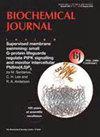Extracellular Vesicle-Linked Vitamin B12 Acquisition via Novel Binding Proteins in Bacteroides thetaiotaomicron.
IF 4.3
3区 生物学
Q2 BIOCHEMISTRY & MOLECULAR BIOLOGY
引用次数: 0
Abstract
Vitamin B12 (cobalamin) and related cobamides are essential cofactors for many gut bacteria, yet their acquisition requires complex uptake systems due to limited availability. In the human gut commensal Bacteroides thetaiotaomicron, cobamide uptake is mediated by multiple operons encoding outer membrane proteins, transporters and uncharacterised lipoproteins, some of which are incorporated into bacterial extracellular vesicles (BEVs). Here, we advance the functional and structural understanding of this cobamide acquisition system by examining previously uncharacterized features. Bioinformatic and promoter-reporter analyses revealed four uptake operons, including novel genes we designate btuK, btuJ, btuL and btuX, with evidence for internal promoters and riboswitch regulation. Recombinant expression and binding assays identified ten cobamide-binding proteins, including three novel lipoproteins (BtuK1, BtuJ1 and BtuJ2). Biophysical measurements demonstrated affinities in the nano- to picomolar range, with BtuJ proteins displaying exceptionally tight binding. High-resolution crystal structures of BtuJ1 and BtuJ2 revealed an augmented β-jelly-roll fold, with conserved tyrosine residues forming a "halo" around the corrin, suggesting a conserved binding mechanism within the IPR027828 protein family. Comparative proteomics of cells and BEVs under cobamide starvation showed selective enrichment of BtuJ and BtuL in BEVs. Functional assays demonstrated that BEV-mediated cobamide uptake depends specifically on BtuJ1 and BtuJ2, whereas BtuL promotes early-phase BEV release. These findings establish the BtuJ proteins as critical BEV-associated cobamide-binding components, provide structural insights into their tight binding, and suggest a model where BEVs act analogously to siderophores, capturing cobamides for delivery to cells. This work highlights the central role of BEVs in microbial nutrient competition.在拟杆菌中通过新的结合蛋白获得细胞外囊泡连接的维生素B12。
维生素B12(钴胺素)和相关钴胺素是许多肠道细菌必不可少的辅助因子,但由于可用性有限,它们的获取需要复杂的摄取系统。在人类肠道共生拟杆菌(Bacteroides thetaiotaomicron)中,cobamide的摄取是由编码外膜蛋白、转运蛋白和未表征脂蛋白的多个操纵子介导的,其中一些操纵子被合并到细菌细胞外囊泡(BEVs)中。在这里,我们通过检查以前未表征的特征来推进对这种共聚物采集系统的功能和结构理解。生物信息学和启动子报告分析揭示了四个摄取操纵子,包括我们命名为btuK, btuJ, btuL和btuX的新基因,以及内部启动子和核糖开关调控的证据。重组表达和结合实验鉴定了10种钴酰胺结合蛋白,包括3种新型脂蛋白(BtuK1、BtuJ1和BtuJ2)。生物物理测量显示在纳米到皮摩尔范围内的亲和力,BtuJ蛋白显示出异常紧密的结合。BtuJ1和BtuJ2的高分辨率晶体结构显示出增强的β-果冻-卷折叠,保守的酪氨酸残基在corrin周围形成“晕”,表明IPR027828蛋白家族中存在保守的结合机制。combamide饥饿下细胞和bev的比较蛋白质组学显示,bev中BtuJ和BtuL选择性富集。功能分析表明,BEV介导的cobamide摄取特异性依赖于BtuJ1和BtuJ2,而BtuL促进早期BEV释放。这些发现证实了BtuJ蛋白是与bev相关的钴酰结合的关键成分,提供了它们紧密结合的结构见解,并提出了一个bev类似于铁载体的模型,捕获钴酰并将其递送到细胞中。这项工作强调了bev在微生物养分竞争中的核心作用。
本文章由计算机程序翻译,如有差异,请以英文原文为准。
求助全文
约1分钟内获得全文
求助全文
来源期刊

Biochemical Journal
生物-生化与分子生物学
CiteScore
8.00
自引率
0.00%
发文量
255
审稿时长
1 months
期刊介绍:
Exploring the molecular mechanisms that underpin key biological processes, the Biochemical Journal is a leading bioscience journal publishing high-impact scientific research papers and reviews on the latest advances and new mechanistic concepts in the fields of biochemistry, cellular biosciences and molecular biology.
The Journal and its Editorial Board are committed to publishing work that provides a significant advance to current understanding or mechanistic insights; studies that go beyond observational work using in vitro and/or in vivo approaches are welcomed.
Painless publishing:
All papers undergo a rigorous peer review process; however, the Editorial Board is committed to ensuring that, if revisions are recommended, extra experiments not necessary to the paper will not be asked for.
Areas covered in the journal include:
Cell biology
Chemical biology
Energy processes
Gene expression and regulation
Mechanisms of disease
Metabolism
Molecular structure and function
Plant biology
Signalling
 求助内容:
求助内容: 应助结果提醒方式:
应助结果提醒方式:


